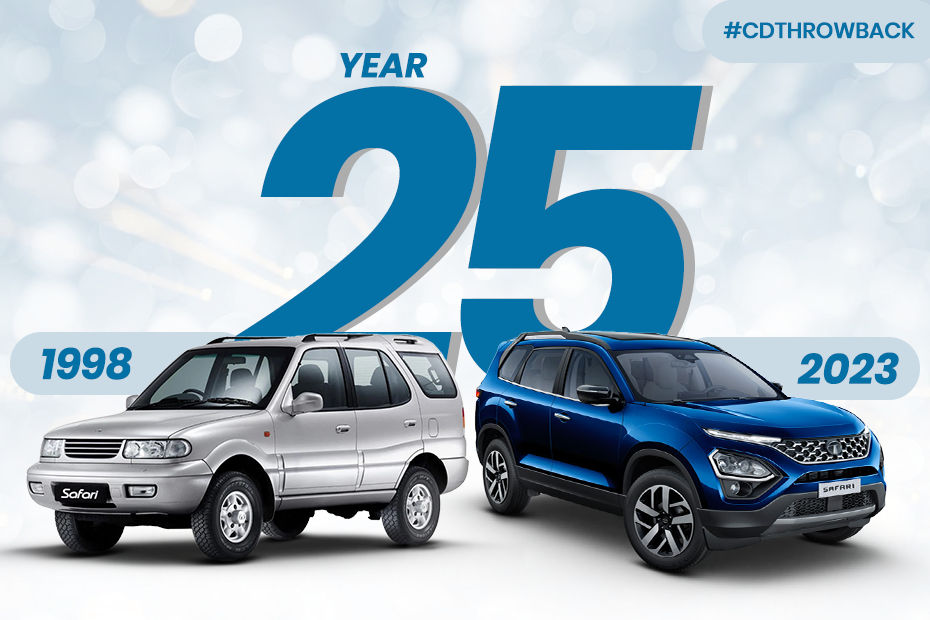25 Years Of Tata Safari: How The Iconic SUV Shed Its Rugged, Macho Tag For A More Family-Friendly Image
Modified On Mar 24, 2023 01:37 PM By Tarun for Tata Safari 2021-2023
- 16.5K Views
- Write a comment
The Safari is now in its third generation but is a completely different character compared to the original

The Tata Safari is one of the oldest running nameplates in India and on its way to completing its silver jubilee. It made its debut back in Auto Expo 1998 and was the first SUV to be designed, developed, and manufactured entirely in India. Today, it’s one of the most sought-after cars in the used market and seen as a trophy or a collectible.
The Safari on sale today is poles apart from the original, but that isn’t necessarily a bad thing. Let’s see the first and the latest iterations of the SUV side-by-side and observe how much the Safari brand has changed:
OG Safari: The Wild One
The 1998 Tata Safari was a premium 4X4 SUV with a price tag of around Rs 8 lakh! High ground clearance, beefy cladding, the tall-boy look, and the tailgate-mounted spare wheel completed its macho looks. Every person of influence, from politicians to film stars and even gangsters, wanted a Safari. Then there was the demand from the SUV aficionados as well.
It came with a body-on-frame platform, which meant being friends with the roughest of terrains but not with regular roads. If you sat in the second row of the original Safari, you would have that bouncy feeling and motion sickness constantly. That felt worse if you found yourself in the jump seats at the back, since it was a seven-seater.

(The Keen Eyed Can Spot All The Versions Of The Safari Here!)
The first Tata Safari debuted with a Peugeot-sourced 2-litre diesel engine, mated to a five-speed manual, having 4WD as standard. It was what we call a ‘real SUV’ which could take the harshest of driving conditions, not care about the potholes, and just keep going for lakhs of kilometres. It did introduce a 2.1-litre petrol engine option as well in 2003. The Safari underwent a series of updates and facelifts from thereon, the two key stages being the Safari DiCor and the Safari Storme (second-gen model).

As impressive as the original Safari was, it was far from perfect. It was tough for the owners to maintain the pre-2005 Safari as it faced gearbox, electrical, and 4X4 lever issues. The Storme was last version on sale, which was discontinued in 2020.
Also Read: How The Hyundai Verna Has Evolved Since Its Debut in India in 2006
Safari Today: One For The Family

25 years later, the Safari badge sits on a very different kind of Tata SUV. This new era Safari entered the market in 2021 and had very little of what made the original so special to the enthusiasts.
The biggest evolution for the Safari is under the skin, as this is now a monocoque SUV with a front-wheel drivetrain only. It is now a more practical family car as it offers a more stable and comfortable ride with better handling qualities. Given that the 4x4 capabilities were considered integral to the previous Safari models, the new one is certainly nowhere near as qualified for off-roading adventures.

While the new Safari still has macho looks and impressive road presence, it is now more chiselled and sophisticated. The Safari is still a three-row SUV but is a lot more comfortable for second and third-row passengers.
It still has a 2-litre diesel unit as its only engine option, this one is sourced from Fiat and claims 170PS of performance. This is the first Safari to offer an automatic transmission option.

This is also the most premium avatar of the Tata Safari to date. With its latest updates for 2023, it comes with ADAS, a large infotainment touchscreen with wireless connectivity, digitised instrument cluster, panoramic sunroof with ambient lighting, and powered front seats.
The latest Safari wasn’t meant to be a ‘Safari’

The Safari name was supposed to retire in 2020, with the discontinuation of the Storme. The last batch was made exclusively for the Indian defence forces. By 2021, Tata was supposed to bring in a replacement three-row SUV for the not-so-successful Hexa, based on its new Land Rover-derived architecture. It was an extension of the Harrier, a five-seater SUV, and was originally revealed in a pre-production avatar with the name ‘Gravitas’. However, Tata had some other plans for the India-spec model, and perhaps a change of heart. Days before the launch, the Gravitas became the Safari, and now, the legend is still alive.
Also Read: These 10 Images Show The Important Details Of Tata Safari Red Dark
What does the Safari name really stand for?

Off-roading enthusiasts and automotive purists will argue that the current Safari is unfitting of its name for its lack of 4WD and a focus on urban comforts. But perhaps that is not what the original Safari was meant to represent. Maybe it was simply the representation of the capabilities of homegrown automaker Tata. In 1998, their aim was to deliver a rugged and capable SUV purpose-built for the Indian market. Today, the company can deliver a large, comfortable and feature-rich SUV that is more attainable than its global counterparts. Maybe, the Safari name is simply for the best Tata SUV to meet the market demands at that time.
Future of The Safari

(Tata Harrier EV Image Used For Reference)
As I write this, I still want to buy the old Safari - or even the Dicor or Storme versions - but that’s just the enthusiast in me talking. The saying ‘New is always better’ works for the Tata Safari. Better yet, there’s an electric one in the works too, and we’ve been promised that it WILL be more capable with an all-wheel-drive powertrain.
Read More on : Safari diesel
1 out of 1 found this helpful















